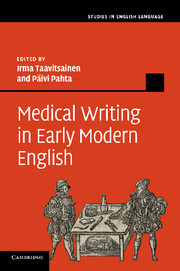Book contents
- Frontmatter
- Contents
- List of plates
- List of figures
- List of tables
- Notes on contributors
- Preface
- List of abbreviations
- 1 An interdisciplinary approach to medical writing in Early Modern English
- 2 Medical texts in 1500–1700 and the corpus of Early Modern English Medical Texts
- 3 Medical literacies and medical culture in early modern England
- 4 Verbs of knowing: discursive practices in early modern vernacular medicine
- 5 Defining in Early Modern English medical texts
- 6 Dissemination and appropriation of medical knowledge: humoral theory in Early Modern English medical writing and lay texts
- 7 Code-switching in Early Modern English medical writing
- 8 New arguments for new audiences: a corpus-based analysis of interpersonal strategies in Early Modern English medical recipes
- 9 Efficacy phrases in Early Modern English medical recipes
- 10 Medical pamphlets: controversy and advertising
- 11 The development of specialized discourse in the Philosophical Transactions
- 12 The expression of stance in early (1665–1712) publications of the Philosophical Transactions and other contemporary medical prose: innovations in a pioneering discourse
- Appendix A Raw data tables corresponding to Figures 4.3–4.14
- Appendix B Raw data tables corresponding to Figures 8.1–8.4
- Appendix C Stance markers used in the analysis in Chapter 12
- Appendix D Preliminary list of texts in the corpus of Early Modern English Medical Texts (EMEMT)
- Bibliography
- Index
2 - Medical texts in 1500–1700 and the corpus of Early Modern English Medical Texts
Published online by Cambridge University Press: 03 May 2011
- Frontmatter
- Contents
- List of plates
- List of figures
- List of tables
- Notes on contributors
- Preface
- List of abbreviations
- 1 An interdisciplinary approach to medical writing in Early Modern English
- 2 Medical texts in 1500–1700 and the corpus of Early Modern English Medical Texts
- 3 Medical literacies and medical culture in early modern England
- 4 Verbs of knowing: discursive practices in early modern vernacular medicine
- 5 Defining in Early Modern English medical texts
- 6 Dissemination and appropriation of medical knowledge: humoral theory in Early Modern English medical writing and lay texts
- 7 Code-switching in Early Modern English medical writing
- 8 New arguments for new audiences: a corpus-based analysis of interpersonal strategies in Early Modern English medical recipes
- 9 Efficacy phrases in Early Modern English medical recipes
- 10 Medical pamphlets: controversy and advertising
- 11 The development of specialized discourse in the Philosophical Transactions
- 12 The expression of stance in early (1665–1712) publications of the Philosophical Transactions and other contemporary medical prose: innovations in a pioneering discourse
- Appendix A Raw data tables corresponding to Figures 4.3–4.14
- Appendix B Raw data tables corresponding to Figures 8.1–8.4
- Appendix C Stance markers used in the analysis in Chapter 12
- Appendix D Preliminary list of texts in the corpus of Early Modern English Medical Texts (EMEMT)
- Bibliography
- Index
Summary
Introduction
English medical texts from the period 1500–1700 are a large and heterogeneous group of writings, including texts circulating in print and manuscript forms on a range of medical topics, representing a variety of genres, written by authors with varying educational and professional backgrounds for different types of target audiences. The 200 years in focus here were a period of important changes from the medieval world view to the first stages of empirical science. In this chapter, we shall first discuss the background and the transmission of medical knowledge with different modes, oral and written, and media, printed books and manuscripts. Sections 2.2 and 2.3 give an overview of medical literature throughout the two-century period. Section 2.4 introduces the Early Modern English Medical Texts (EMEMT), a computer-readable text collection designed to facilitate research on printed medical texts of the period and used as primary material in the studies in this book.
Printing and manuscript circulation
Dissemination of medical knowledge underwent major changes in the early modern period. The advent of printing introduced a new technology that enabled the production of multiple copies of a text more quickly and more cheaply than had been possible with copying by hand. This affected both the more prestigious kinds of text, those produced by learned men, and those texts that were meant to provide basic medical information to laypeople, for instance almanacs that might sell for 2d.
- Type
- Chapter
- Information
- Medical Writing in Early Modern English , pp. 9 - 29Publisher: Cambridge University PressPrint publication year: 2011
- 5
- Cited by



